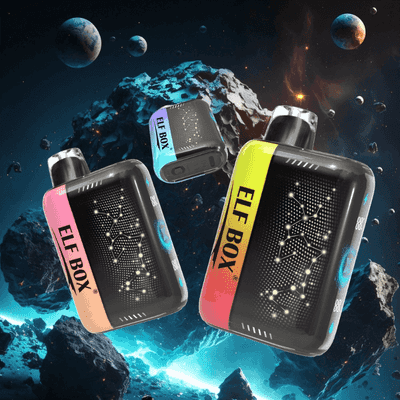Organic Vape: 2025 A Green Revolution Amidst The Great Health Fog Or A Carefully Designed Marketing Illusion?
Late at night at a Los Angeles health food store, rows of vape products bearing the “USDA Certified Organic vape” label quietly occupied prime real estate next to the checkout counter. Emma, a young clerk, expertly promoted the product: “This organic blueberry vape juice is sourced from a certified farm in Vermont. Even the nicotine is pure plant-derived salt.” Nearby, at the New York University Public Health Laboratory, researcher Dr. Chen was disassembling a cartridge advertised as “100% organic.” The pulsing curves on the chromatograph were about to reveal the truth behind the global “organic vaping revolution.”

The organic wave: consumption upgrade from dining tables to atomization warehouses
After a decade of organic vegetables taking center stage on supermarket shelves, the green revolution is finally sweeping the vape market. The global organic vape market is expected to exceed $8.7 billion by 2025, with an annual growth rate of 31.5%. This is driven by consumers’ ultimate pursuit of “pure food”:
- A raw material revolution: The PG (propylene glycol) in traditional vape juice is replaced by organic vegetable glycerin, which must come from non-GMO organic crops (such as French organic beetroot). The American brand “PureVapors” even publishes a traceability map of the farms used for its organic mint.
- Nicotine Purification: Leading companies use supercritical CO2 extraction technology to extract nicotine from certified organic tobacco leaves, avoiding petroleum synthesis. Test reports for the British brand “NaturNic” show nicotine purity of 99.97%, with heavy metal residues below instrument detection limits.
- Flavor Reconstruction: Artificial flavors are replaced with cold-pressed organic citrus oils and distilled herbal extracts. German “BioVape” apple-flavored vape juicerequires 32 organic apples to produce a single 30ml bottle, costing up to five times the price of regular vape juice.

Health paradox: Can organic vape juice break the safety curse of vape?
Although organic ingredients reduce known risks, core conflicts remain unresolved:
- Unknowns about atomization: “Even when using organic strawberry extracts, the compounds produced by high-temperature atomization may still exceed safety limits.” The Johns Hopkins University toxicology team warned in the journal Environmental Health Perspectives that their research found that the concentrations of new carbonyl compounds generated by some organic flavors after atomization are higher than those of artificial flavors.
- The nature of nicotine: The University of California, San Francisco emphasizes: “Organic nicotine and traditional nicotine are exactly the same in molecular structure, and there is no difference in their addictiveness and cardiovascular effects.” The so-called “healthier” nicotine is actually a marketing tactic.
- Lung cell experiment: An in vitro study conducted by Seoul University in 2025 showed that the stimulation intensity of the inflammatory factor IL-6 in human alveolar epithelial cells (A549) by atomized extracts of organic vape juicewas only 11.3% lower than that of traditional vape juice, far from reaching the “safe” threshold.
Future Path: The 3.0 Evolutionary Direction of Organic Vape
Organic vape, which are moving forward amid controversy, are starting to use technology to save themselves:
1.Blockchain traceability system
UK startup GreenCloud has developed a platform for tracing vape juice ingredients throughout the entire supply chain. Consumers can scan a QR code to view the harvest date of organic glycerin, nicotine extraction batches, and even the flavorist’s work log. This immutable data eliminates the black box nature of the supply chain.
2.Biodegradable Devices
Dutch brand EcoVape has launched its first compostable vape cartridge, featuring a shell made of a cornstarch-based polymer and a built-in bamboo fiber atomizer. With a 90-day biodegradability rate exceeding 82%, it addresses the issue of plastic pollution in e-cigarettes.
- AI-driven, personalized, and safe vaping. Equipped with a smart chip, the “Adapt Organic” device monitors atomization temperature and power combinations in real time, automatically avoiding areas known to produce harmful substances. The user app displays a real-time health index: “Current Vaping Safety Rating: A-, Recommended Single Inhalation: No More Than 2.1 Seconds.”

A guide to rational consumption: 5 tools to penetrate the fog of marketing
Faced with a mixed market, smart consumers need to be equipped with scientific knowledge:
- Verify dual certification: Look for “raw material organic certification” + “production process certification” (such as ISO-GMP), a single label is not enough
- Review test reports: Require merchants to provide third-party heavy metal and aldehyde and ketone test data (limits should be 50% lower than FDA regulations)
- Beware of absolute rhetoric: “Completely harmless” and “zero risk” claims violate basic scientific principles
- Prioritize local procurement: Choose products under the domestic regulatory system. Cross-border purchases of organic e-liquids carry high legal risks.
- Understanding the essence of health: Organic vapeare still harm-reducing products, non-smokers should not try them
When an organic vape experience center in Manhattan uses a vertical farm as its product background wall, and when a Berlin designer replaces the cigarette rod packaging with germinable seed paper, this green revolution has gone beyond the product itself and become a mixture of consumerism and health anxiety.
“The core of the problem isn’t whether something is organic or not, but whether we’re replacing one sophisticated illusion with another,” sociologist Erica Thompson noted in The Age of Vaping. “When young people pay a luxury premium for ‘organic nicotine,’ healthy consumerism is completing the domestication of a new generation.”
The organic evolution of organic vape will ultimately face the ultimate question: Is it truly building a safer and less harmful path, or is it simply cloaking an addictive product in a new guise of moral legitimacy under the guise of sustainable development? The answer lies not in laboratory reports, but in the clear-eyed understanding and choice of each consumer when they press the atomizer button.

